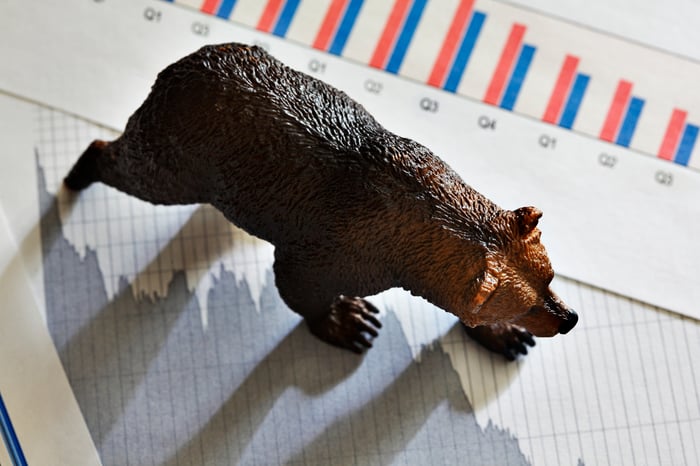The past two years have been night-and-day different for investors. In 2021, the benchmark S&P 500 (^GSPC -0.89%) endured no more than a 5% correction, with the Dow Jones Industrial Average (^DJI -1.27%) and Nasdaq Composite (^IXIC -1.29%) being lifted to new highs.
Meanwhile, in 2022, the Dow, S&P 500, and Nasdaq Composite all entered respective bear markets, with the three indexes delivering their worst full-year returns since the Great Recession. The growth-oriented Nasdaq was hit particularly hard, with the index losing a third of its value.

Image source: Getty Images.
Although moves lower in the market can be unnerving, they're more commonplace than you probably realize. There have been 39 separate double-digit percentage declines in the S&P 500 since the beginning of 1950, according to data from sell-side consultancy company Yardeni Research. That's one correction, on average, every 1.87 years.
But the data point that tends to eat at investors isn't when corrections or bear markets will occur so much as when they'll end. Although there isn't an indicator or metric that will conclusively tell investors precisely when a bear market will bottom, there is a stock market indicator that hasn't been wrong after World War II, which has a phenomenal track record of predicting which collective direction stocks will head next.
This stock market indicator has been infallible for nearly eight decades
In the more than 77 years since World War II ended, there have been 13 bear markets. Although there's no rhyme or reason as to how much these 13 bear markets have ultimately declined, there is a well-defined pattern when it comes to bear markets finding a bottom.
According to data from Chief U.S. Strategist Ed Clissold of Ned Davis Research, the common theme the previous 12 bear markets shared (i.e., excluded the current bear market) is they didn't bottom until an official recession was declared by an eight-economist panel of the National Bureau of Economic Research (NBER).
As you can see from the table below, it's taken a median of 5.3 months, and an average of nearly 6 months, for every bear market after World War II to find its bottom.
| Bear Market Start | Recession Start | Recession Start to Bear End (Months) |
|---|---|---|
| Jun. 15, 1948 | Nov. 30, 1948 | 6.4 |
| Jan. 5, 1953 | Jul. 31, 1953 | 1.5 |
| April 6, 1956 | Aug. 31, 1957 | 1.7 |
| Jan. 5, 1960 | April 30, 1960 | 5.8 |
| Dec. 3, 1968 | Dec. 31, 1969 | 4.8 |
| Jan. 11, 1973 | Nov. 30, 1973 | 12.2 |
| Sept. 8, 1978 | Jan. 31, 1980 | 2.7 |
| April 27, 1981 | Jul. 31, 1981 | 12.4 |
| Jul. 16, 1990 | Jul. 31, 1990 | 2.4 |
| Jan. 14, 2000 | March 31, 2001 | 5.7 |
| Oct. 9, 2007 | Dec. 31, 2007 | 14.3 |
| Feb. 12, 2020 | Feb. 29, 2020 | 0.8 |
| Jan. 4, 2022 | N/A | N/A |
Data source: Ned Davis Research. Table by author.
Since Wall Street tends to be forward-looking, it's not surprising that the stock market regularly bottoms prior to the end of a recession. However, it's also plainly obvious from this dataset that investors aren't accurately factoring in the short-term corporate earnings pain that typically accompanies a recession.
The question is: How close is the U.S. economy to a recession?
Recession-forecasting tools offer a warning for Wall Street
In order for the above data to be relevant, the U.S. economy would have to, officially, fall into a recession. Based on a couple of recession-forecasting tools, there appears to be a growing likelihood of that happening.
Arguably the most-followed recession-probability tool is the New York Federal Reserve's indicator that analyzes the spread (i.e., difference in yields) between the three-month and 10-year Treasury bonds. Historically speaking, when the yield curve inverts and longer-dated bonds have lower yields than shorter-maturing bonds, bad things tend to happen. Currently, the yield-curve inversion between the three-month and 10-year T-Bond is the widest it's been in almost 42 years.
To be perfectly clear, the NY Fed's recession-forecasting tool has been wrong before (October 1966). But over the past 56-plus years, if the recession-probability tool has topped 32%, there has been a U.S. recession not long after. It's currently at a 54.49% likelihood of a U.S. recession within 12 months.
US ISM Manufacturing New Orders Index data by YCharts. Gray areas denote U.S. recessions.
It's a somewhat similar story for the U.S. ISM Manufacturing New Orders Index. This is an index that analyzes new industrial orders in the United States. Even though the U.S. economy is more reliant on technology and software than ever before, industrial orders can still offer meaningful insights into the health of the economy.
The U.S. ISM Manufacturing New Orders Index is reported on a scale of 0 to 100, with 50 representing a neutral baseline where orders are neither growing nor slowing. A figure above 50 represents industrial order expansion, whereas a number below 50 implies order contraction.
Dating back 70 years, a U.S. recession has materialized anytime the U.S. ISM Manufacturing New Orders Index has fallen below 43.5 (no matter how brief the time frame). In January 2023, it fell to 42.5 before rebounding a bit in February.
No bear market has bottomed prior to the NBER declaring a recession, and most signs appear to point to a high likelihood of a U.S. recession in the not-too-distant future. In other words, there's a reasonable chance the Dow, S&P 500, and Nasdaq have yet to see their bear market lows.

Image source: Getty Images.
This number has been foolproof for more than a century
Once again, I want to repeat that effectively nothing is foolproof on Wall Street. Although these indicators have been spot-on for more than a half-century, it's always possible this could be the time things go differently.
However, there is one number that has provided a virtual guarantee to investors for more than a century -- and all it requires is patience.
Every year, market analytics company Crestmont Research updates the total returns, including dividends, of what an investor would have made had they, hypothetically, purchased an S&P 500 tracking index at any point since the beginning of 1900 and held for 20 years. Crestmont's dataset is essentially an exercise in using time as an ally.
Following its most recent update, Crestmont's data showed that all 104 rolling 20-year holding periods (1919-2022) since the beginning of 1900 produced a positive annualized total return. In simple terms, you made money 100% of the time if you bought an S&P 500 tracking index and held 20 years, regardless of when you made your initial purchase. In many instances you made quite a bit of money, with over 40% of the 104 ending years yielding an annualized total return of at least 10.8%.
The point being that bear markets are all, eventually, just a blip over the long run. Even if the Dow Jones, S&P 500, and Nasdaq Composite haven't yet found their respective bottoms, right now represents as good a time as any for long-term-minded investors to put their money to work in high-quality businesses, index funds, and exchange-traded funds of their liking. As long as time is your ally, no indicator or metric should prove all that worrisome.





